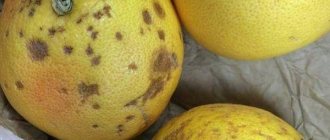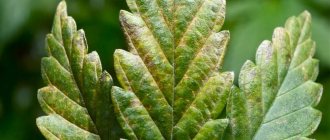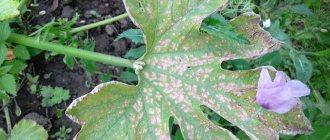Photo: botanichka.ru Despite the popularity of pepper and the diversity of its varieties, it is still a rather capricious crop. She often suffers from fungi, viruses, pests and other diseases. To notice the symptoms in time, regularly inspect the leaves in the beds. We tell you what changes happen and what they indicate!
Pimples and tubercles on leaves
Periodically, pests settle on the leaves, lay eggs and leave behind their waste products. This is the most common reason why plates become covered with tubercles, although not the only one!
— Large tubercles form on peppers due to aphids, which thus multiply and leave galls;
— Small light green pimples are oedema or dropsy, and they are formed due to edema. Basically, the reason is constant overflow, lack of light or too low a temperature;
— Growths on the back side occur when peppers are planted in a greenhouse. When the soil is too warm and the air is cold, the plant’s metabolic processes are disrupted;
- Sometimes small bumps can be a kind of irritation. This is a stress response after transplanting seedlings to a site with radically different conditions;
— Tubercles resembling warts are left behind by the whitefly;
— Oval large growths that cannot be gotten rid of appear due to scale insects.
Photo: zemeljka.ru
Non-communicable diseases
Pepper diseases caused by unfavorable climatic conditions are classified as non-infectious diseases.
Non-communicable diseases are caused by the following conditions:
- lack of nutrients
- temperature changes,
- lack or excess of sunlight.
We recommend watching how to care for indoor peppers.
Pepper blossom end rot
Watery spots form on the tops of plants, then they dry out. The cause of blossom end rot in peppers is calcium deficiency. The disease can be triggered by changes in air humidity, excessive application of nitrogen fertilizers, and uneven watering.
To combat the disease, remove the affected areas of the plants and spray with 0.3-0.4% calcium chloride.
Dropsy
Another name for it is oedema or edema. Plants develop growths on the back of the leaves and stems. Occurs in seedlings under unfavorable conditions.
The reasons are:
- lack of lighting,
- excessive watering, find out what kind of water and how often to water the peppers,
- lack of nutrients.
When transplanting seedlings and proper care, everything returns to normal.
Leaves turn yellow and dry out
There are dozens of reasons why leaves turn yellow, from natural biological processes to serious diseases. Sometimes it’s a matter of violation of agricultural technology and conditions for keeping pepper.
- When yellowness spreads evenly across the leaves from the veins, the cause may be a lack of iron;
— Leaves turn yellow and dry from the tips upward when they lack calcium. And if they also begin to die, the problem is boron deficiency. It’s better not to guess and immediately use a comprehensive balanced feeding;
— Chaotic yellow spots intertwined in mosaic patterns indicate the disease of the same name. There are several types of mosaic, but all of them are incurable;
— Lack of moisture on hot days is another reason why pepper leaves look and feel sick;
— If you water the garden at the height of the day, burns may remain on the leaves;
— When the lower leaves first turn yellow and fall off, it’s time to feed the pepper seedlings with fertilizers;
— Leaves may turn yellow due to sudden hypothermia, if frost strikes or if you forget to close the balcony.
Photo: wireelectric.ru
Leaf diseases in phlox: descriptions with photos, treatment
Preventive actions
Prevention of diseases very often helps to prevent their development in cultivated plants. After all, it is well known that preventing a problem is easier than fighting it.
Feeding and prevention of pepper diseases - video
The main recommendations for preventing diseases in bell peppers are as follows:
- In the autumn, it is necessary to dig up the soil to a depth of one spade bayonet. In this case, all pathogenic microorganisms, pests and their larvae, hidden in the ground from frost, will end up on the surface of the earth and freeze in winter.
- It is also necessary to follow the rules of crop rotation - bell peppers should not be planted in one place for several seasons in a row, and they should not be grown after other vegetable crops from the Solanaceae family. This crop can be planted in one place after two or three seasons. Otherwise, diseases that are the same for all plants from the Solanaceae family will accumulate in the soil; as a result, all vegetable crops will be affected by them almost 100%.
- Compliance with the irrigation regime is another important aspect in disease prevention. It is best to arrange drip irrigation in garden beds. If the soil is constantly waterlogged, the peppers will be affected by various putrefactive bacteria and fungal diseases. During rainy periods, the amount of watering should be reduced as much as possible.
Even these simple rules can maximally protect bell peppers from pathogenic microorganisms. The main diseases and measures to combat them will be described below.
EXCELLENT VARIETIES OF PEPPERS!
Sweet pepper Claudio F1 Pepper Gogoshary
Brown spots on pepper leaves
Fungal diseases most often appear in the form of dark spots. They develop especially actively on warm, humid days, in the most comfortable environment for themselves.
— Leaves darken as if they swell and soften as they rot. Urgently reduce watering and preventively treat the pepper against fungus;
— Leaves darken and veins turn purple when affected by mycoplasmosis. The disease begins with the upper young plates and gradually moves to the lower ones;
- Brown and seemingly watery spots, which eventually turn into ulcers, are left by bacterial spotting;
— In wet weather, brown spots that gradually turn gray or black are a symptom of vegetable brown spot;
— Brown spots, tumors, ulcers and other defects on leaves and shoots are caused by bacterial cancer;
— Yellow-brown spots and deformed stems are the consequences of the fact that the root system is destroyed by nematodes;
— Dark spots are left by another fungus - cladosporiosis. Its peculiarity is that on the reverse side these spots are covered with an olive coating.
Photo: pugachevsky-site.ru
Pests
In open ground and greenhouses, bell peppers can be attacked by phytophagous insects. Pests cause significant damage to vegetable growing, and with a sharp increase in the population, they can completely leave the gardener without a harvest.
Nematodes
Nematodes are classified as roundworms. They are parasitic on many plants, including sweet peppers.
There are three types of nematodes: root, stem and leaf. Most often, nightshade crops are affected by a pest that parasitizes the roots of plants.
Spread occurs through contaminated soil, soil and seed. More often found in greenhouses due to the difficulty of maintaining crop rotation.
Peppers affected by the pest stop developing and chlorosis appears on the leaves. When removing a diseased plant from the ground, galls, which are spherical thickenings, can be found on the roots.
Today there are few sufficiently effective means of protection against nematodes. Traditional insecticides and fungicides do not work on the parasite, as it is a roundworm.
To combat the pest, the chemical substance Vidat or the biological product Nematophagin Mikopro are used.
Observing crop rotation, checking plant roots at the end of the season, using mustard powder (half a glass of mustard per hole), and adding Lepidocide or Bitoxibacillin to the soil will help to avoid the accumulation of nematodes.
Spider mite
Favorable conditions for the appearance of spider mites on peppers are dry, hot weather with temperatures above +30 degrees. Most often, the pest is found in greenhouse conditions or in open ground in the south of the country.
The parasitic population of spider mites manifests itself on the plant with such signs as yellow specks on the leaf blades, a gray coating on the inside of the leaves that looks like dust, and a barely noticeable cobweb on the above-ground parts of the pepper.
Vermitek, Karbofos, Antiklesch, Sunmite and other acaricides are used against arachnid pests. Carry out 3 treatments with an interval between each of 7-10 days. It is advisable to alternate drugs so as not to cause resistance in the parasite.
Aphids
Aphids are most often found in greenhouse conditions. The spread of pests is soil contaminated with their larvae.
Ants can contribute to the proliferation of aphid populations. The latter feed on the sweet honeydew secreted by insects and act as their natural protectors. When fighting aphids, first of all you need to destroy all anthills in your garden plot.
The pest is a carrier of viral diseases that threaten the complete death of plants.
When pepper is infected by aphids, a sticky honeydew appears on the vegetative organs, the leaf plates curl, the buds do not open, and the flowers that appear become deformed and fall off.
To destroy pests, insecticides such as Intavir, Actellik and Karbofos are used. In greenhouses, peppers are treated with Clipper. Biological products used include Fitoverm, Entobacterin, and Actotsid.
Cutworm caterpillars
Caterpillars feed on leaves, stems, and roots of peppers. During the daytime they hide in the ground, and at dusk they crawl out.
Cutworms infect plants in greenhouses, greenhouses and open ground. Increased moisture contributes to a rapid increase in the pest population.
To combat cutworm caterpillars, they use the drugs Herold, Alatar, Decis Profi, Initiator 200.
Thrips
The main signs of the appearance of thrips on pepper are deformation of the leaf blades, the appearance of yellow spots on the leaves, and the falling of flowers.
To destroy the pest, peppers must be treated three times with an interval of 10 days with preparations such as Aktara, Fitoverm.
Bedbugs
The pest bites through the pepper fruits and injects poisonous juices. Pepper becomes unsuitable for food, as it acquires a bitter taste and specific smell, and quickly rots.
Insecticides used against pests such as whiteflies and aphids are effective against bedbugs.
Nightshade miner
The pest attacks hot and sweet peppers, both in open and closed ground. Nightshade miner larvae pose a danger to plants. They penetrate into leaf blades, gnawing holes in them.
Favorable conditions for the development of the pest are temperatures from +25 to +30 degrees.
Such remedies as Spinosad, Vermitek, Varant, Tianid are effective against nightshade miner on peppers.
Slugs
Favorable conditions for the reproduction of slugs are temperatures up to +25 degrees and high humidity. The pest feeds at night.
Mollusks gnaw through leaf plates, leaving holes of different sizes on them. The fight against them is carried out with the help of drugs Slug Eater, Thunderstorm Meta, Ferramol.
Wood ash or slaked lime will also help get rid of slugs. The substances are sprinkled on the soil around the pepper bushes.
Wireworm
These pepper pests are click beetle larvae. They live in the ground at a depth of 10-12 cm, feeding on the roots of nightshades and other vegetable crops.
Effective methods of controlling wireworms are the use of drugs and sowing green manure. For prophylactic purposes, Zemlin and Vallar are used.
It is possible to remove the pest using green manure only the next season after its detection.
After harvesting and removing plant debris from the area, rye or mustard is sown. They serve not only as a fertilizer, but also as a means against wireworms. In the spring, after green manure shoots emerge, the area is dug up, after which seedlings can be planted.
Pepper leaves turn black
Necrotic foci indicate an advanced stage of the disease, although less often peppers can turn black for other reasons. The most sensitive to external conditions are young seedlings.
— Black necrotic spots on leaves and fruits appear due to Alternaria blight;
— Young shoots turn black and die when affected by late blight. Dark spots appear on old leaves and on the root collar;
— Black spots with white dots and a greenish halo are a sign of cercospora. Very often it affects only the lower leaves.
Photo: datchnik.ru
Petunia leaf diseases: descriptions with photos, treatment
Diseases caused by fungi
Fungal infection in bell and other peppers is a common occurrence. Spores can be carried by the wind, with the help of rain and insects, and remain on plant debris in the ground. At the first manifestations, you should immediately take appropriate measures, as this can lead to the death of plants.
Blackleg
The most common type of disease occurs in sweet and bitter peppers. Threatens seedlings from the moment of emergence until the 3rd true leaf. Accompanied by such signs as a dark stem at the base (hence the name) and its constriction. Occurs as a result of increased soil moisture. Leads to complete death.
The spores are found in the upper layer of soil and, when a favorable environment is created, they infect the crop. Other factors can also provoke the development of the disease - poor ventilation, thickened seeding, temperature changes.
Prevention and control measures if seedlings become sick with blackleg:
- Purchasing quality planting material.
- Treating your own collected seeds. They can be treated with a non-concentrated solution of potassium permanganate. After which the seeds are washed and dried. You can use drugs that stimulate the immune system.
- Processing soil mixture intended for seedlings. To do this, you will need a non-concentrated solution of potassium permanganate, or you can purchase special preparations, for example, “Baikal”.
- Adding the drug “Trichodermin” to the soil.
- Timely picking.
- Constantly ventilate the room where the seedlings are located.
- Frequent light watering.
- Removing affected plants.
It is better to choose peat containers for growing that are already prepared for planting.
Gray rot
This disease is characterized by the appearance of spots on the lower part of the stem that become wet, brown in color, and covered with a gray coating. Spores are well preserved in soil and plant debris. A favorable environment for development is high humidity.
The fight against damage involves carrying out preventive measures, removing the diseased plant, treating affected crops with activated carbon or chalk, copper sulfate and other protective drugs.
Late blight
At the initial stage of development, it can be confused with a black leg, since a dark constriction appears at the base of the stem. Afterwards you can notice a white coating.
To combat and prevent this disease, you should adhere to the following recommendations:
- purchase of high-quality planting material;
- tillage of soil intended for planting;
- feeding seedlings with potassium-phosphorus fertilizers;
- combating damage at the initial stage with special drugs;
- removal of a heavily affected plant.
Fusarium
This disease is characterized by causeless wilting of seedlings, which gradually began to lose foliage. The affected crop will definitely have brown veins on the stem cut. Fusarium always affects the root system, causing it to rot. As a result, the seedlings stop receiving nutrients and die.
Spores spread quickly, which can be facilitated by high humidity, temperature changes, lack of nutrients in the soil, and damage by insects. It is difficult to recognize the disease at the initial stage.
Treatment and prevention if seedlings are sick with fusarium:
- Purchasing quality planting material.
- Treating your own collected seeds.
- Processing soil mixture intended for seedlings.
- Adding the drug “Trichodermin” to the soil.
- Timely picking.
- Constantly ventilate the room where the seedlings are located.
- Frequent but light watering.
- Removing affected plants.
White coating on pepper leaves
Fungal infections are not only spots, but also a characteristic coating that is left behind by mycelium with spores. Although sometimes inexperienced gardeners confuse a thin translucent cobweb with a white coating.
— The main creator of the white web on pepper leaves is the spider mite. Most often it hides on the back of the leaf;
— Light spots with a slight grayish tint remain when affected by gray rot;
— A white coating, reminiscent of velvet or tiny hairs, is left by powdery mildew;
- Downy mildew is practically no different either in manifestations or in treatment, but it is darker.
Photo: botanichka.ru
Pale and light leaves
Pepper can not only become stained, but also appear to fade completely. New young or already growing old leaves fade - and there are several reasons for this!
— Pepper leaves immediately grow weak and pale if they lack nitrogen during green growth;
— Young leaves grow faded and weak if agricultural practices are violated;
— Large white spots that spread over the entire leaf appear due to another type of viral mosaic - alfalfa.
Photo: teplica-one.ru
Diseases of raspberry leaves: descriptions with photos, treatment
Pepper leaves curl
When leaves curl, curl, or become misshapen, this is a warning sign because the problem could be a virus. Although there are several less radical reasons!
— Pepper leaves may curl if they are severely lacking in light. Most often this happens with home seedlings, so it’s worth taking them out onto the balcony;
— Sometimes large leaves curl up if the planting is too thick. They simply lack space and oxygen;
— Leaves curl, wither and wilt due to verticillium wilt. Usually after this they do not fall off, but remain hanging.
Photo: cvety-na-dache.ru
Did you like the post? Subscribe to our channel in Yandex.Zen, it really helps us in our development!
Disease Prevention
As you can see, most diseases cannot be cured. Therefore, preventive measures are important:
- it is necessary to treat the seeds before planting;
- in the fall, dig up the area to a depth of 25 cm so that the pathogens die;
- It is advisable to disinfect the ground with a concentrated solution of manganese;
- disinfect garden tools;
- promptly remove and burn disease-affected plants;
- do not plant plants in the same place for 2 years in a row and after nightshades;
- feed, weed and water plants in a timely manner;
- plant herbs and ornamental crops in the garden, such as marigolds, nasturtiums, etc.











